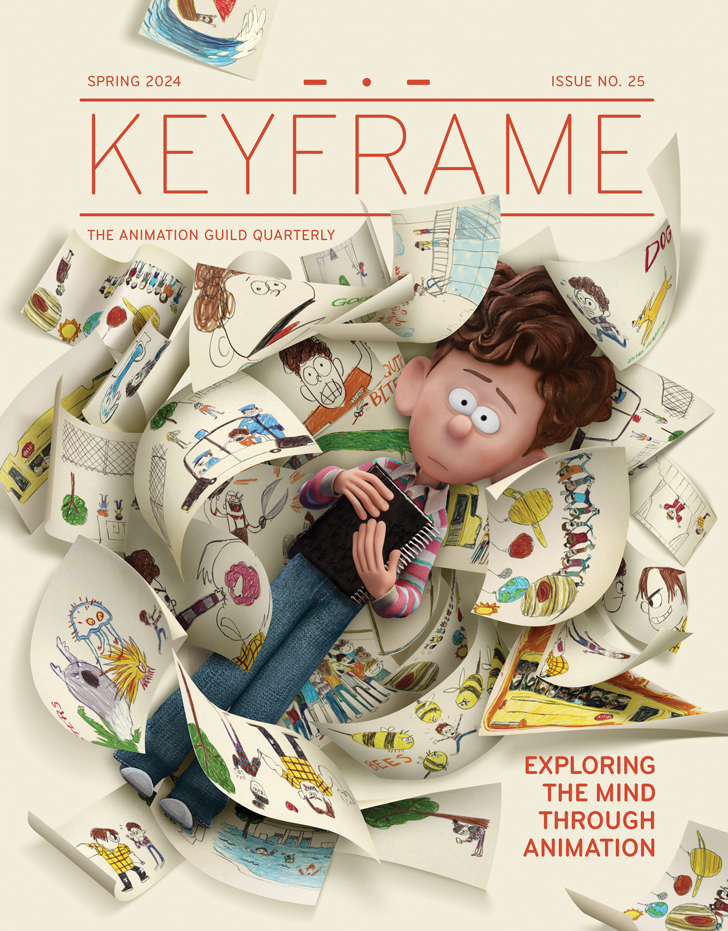
By the time John Musker retired, it had been decades since he’d worked as an animator. A 40-year veteran of Walt Disney Animation Studio, he wrote and directed numerous films—including The Little Mermaid, Aladdin, and Moana—with his partner Ron Clements. But when he decided to make the short film I’m Hip, he returned to his roots. “I wanted to celebrate the magic trick that still thrilled me: drawings coming to life,” he says.
I’m Hip is a music video of sorts, a groovy, free-wheeling collage animated to the song of the same name composed by Dave Frishberg and Bob Dorough. “I loved the wittiness,” Musker says. “When I heard it years ago, I got pictures in my head as to how I might visualize it. Dave’s lyrics, his deadpan delivery, and his sardonic jazz ‘fills’ on the piano all helped shape the narrative.”
Musker describes this narrative as a “first-person comic ‘brag’ that skewers self-absorbed people who are desperate to always be on the cutting edge. The lyrics catalogue the singer’s many examples of hipness, which I wanted to illustrate, so the ‘story’ is a loose soliloquy of sorts.”
The singer in I’m Hip is a soul patch-sporting, fedora-wearing cat who flits from scene to scene, with each scene being its own tongue-in-cheek tableau of perceived hipness, from an arty French flick to a Beatnik café to running with the bulls. While it feels like an abstract ride, Musker notes the song’s structure with a clear introduction, verse and choruses, and recitative bridge where the bass and drum rhythm section drop out—it then returns to an up-tempo pace that leads to a comic coda Musker says “felt very funny to me and a satisfying way to truly bring the song to a rousing finish.”

Musker worked meticulously with the song’s structure, using it as a framework for the cool cat’s actions and to emphasize humor. “For example, when [Frishberg] did that low register ‘I’m hip … oh, I’m hip … yes, I’m hip,’ I thought it sounded like he was underwater,” Musker says. “So I concocted a way to get the cat thrown off the rooftop jazz club and plunge into the river. Then the following glissando seemed like I could use it as a fishing line, yanking him up and out of the water into a fisherman’s arms. I wanted all the animation to support and amplify the track.”
For the look, Musker reflected on the classic Hollywood animation he grew up with, not only from Disney movies, but also from Warner Bros. and MGM shorts he saw on TV. “I was also influenced by the jazz record album art of the ‘50s and ‘60s, particularly the work of David Stone Martin, one of the premier illustrators of that period,” he says. “He used a scratchy pen line and spotted areas to drop in solid black shapes. And he utilized washes of flat colors which didn’t conform to the ink drawing. The result was a very ‘jazzy’ improvisational look.”

To achieve this style, Musker drew all of the animation with a stylus on his Cintiq and used TVPaint to animate. “I wanted the final look to have that scratchy pen and ink line, which would have been difficult to achieve on paper, but TVPaint had brushes that could do that,” he says.
Because Musker knew absolutely nothing about TVPaint, he took the advice he says he would give to young animators thinking about doing an independent short film: “See if you can enlist collaborators who are expert at their jobs.” He’s quick to give credit where credit is due, from “Jennifer Yuan’s cool layouts [to] Ken Slevin’s beautiful backgrounds.” Talin Tanielian is credited on the film as Editor, Compositor, Shot Supervisor, and Production Manager, and he says, “If I didn’t have her, I would still be trying to finish the short.”

But Musker isn’t just grateful for the people who helped him make the film. He appreciates everyone he’s encountered on his animation journey. This makes the film more than just a fun romp. “I am addicted to drawing caricatures,” he says. “Ever since I saw Mort Drucker in Mad, I have been compelled to do my own.”
This compulsion led to more than 120 caricatures in the four-minute film. Along with the people who worked on it and his family, he says, “I couldn’t resist also adding some of my CalArts classmates and their wives and significant others. And people like [animation legends] Glen Keane, Eric Goldberg, and Bill and Sue Kroyer.” He also caricatured two of the hippest guys he says he’s ever worked with—Taika Waititi and Lin-Manuel Miranda: “I couldn’t do a movie about hipness without getting them in there, however briefly.”
With so much personal investment, it would seem impossible for him to choose a favorite moment in the film, but he does have one. He notes the animation he did in a scene of the cat in a jazz club “bounding across the floor, plopping onto the stage to soak in the licks coming from a sax player.” Of course, the musician is a friend, [Story Artist] and jazz saxophonist Jeff Snow. But that’s not all that makes this stand out for Musker. Throughout the project he had a specific vision of the timing, phrasing, and looseness he wanted. It is in this scene where he sees the manifestation of the magic trick he sought—drawings come to joyous, playful, bah-bah-doo-bebop life.







.png)